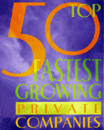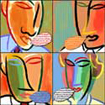Fall 2004
Values at Work
 Political campaigns always remind me of how much we are formed
and shaped by our value systems. Although we think of ourselves as rational
and reasonable
people, responsive to data and logic, it is also clear that values inform and
direct our choices and behavior, both in the workplace and outside of it. In
this political season, we are acutely aware of how our personal values attract
us to those whom we believe agree with and represent those values—in
many cases, we do so even when our vested interests might argue for another
choice.
Campaign rhetoric often refers to those values and speaks directly to the “true
believers” of the left or the right, polarizing the debate. Civil discourse
across boundaries of values and belief systems can be very difficult. In organizations,
the “true believers” may represent different technologies or different
visions for the future. Here, too, civil discourse—or what we have come
to refer to as “constructive debate”* is too often replaced by
repetitive arguments and unproductive conflict.
Political campaigns always remind me of how much we are formed
and shaped by our value systems. Although we think of ourselves as rational
and reasonable
people, responsive to data and logic, it is also clear that values inform and
direct our choices and behavior, both in the workplace and outside of it. In
this political season, we are acutely aware of how our personal values attract
us to those whom we believe agree with and represent those values—in
many cases, we do so even when our vested interests might argue for another
choice.
Campaign rhetoric often refers to those values and speaks directly to the “true
believers” of the left or the right, polarizing the debate. Civil discourse
across boundaries of values and belief systems can be very difficult. In organizations,
the “true believers” may represent different technologies or different
visions for the future. Here, too, civil discourse—or what we have come
to refer to as “constructive debate”* is too often replaced by
repetitive arguments and unproductive conflict.
I think that values belong in business discussions and decision-making. In fact, corporate values should become rigorous criteria for decision-making rather than bland slogans. In order for that to happen, however, teams and organizations must examine their stated values and acknowledge their values—in-practice (those that actually inform their decisions). By making our implicit values explicit and by examining the impact of our stated values on day-to-day decisions, we are in a position to make conscious choices about what we stand for as individuals and organizations. In this way, we develop moral and ethical maturity and authenticity.
Our values are indeed “where we come from.” This month is the 95th anniversary of the birth of my “values mentor”—my mother, Lorraine Shapiro. I have been reflecting on what I—and the many others whose life she touched through her family, her friendships, and her many years of work at Kaiser Permanente—learned from her example. This issue’s featured article is a tribute to her.
Because we are so focused on leadership at this time, we are also reprising an article on that topic. I can only hope that, regardless of the results of local and national elections in the U.S. and elsewhere, we will all find our way to more constructive debate, discussion, and resolution of differences, based on important values that we share, in our communities, organizations, and nations.
—Kim
*Constructive Debate: Building Better Ideas™ is one of our newest programs. Click here for the program description. Please read our new item about the program’s launch.
In this Issue:
- “Lorraine’s Laws: Putting Organizational and Personal Values to Work” by B. Kim Barnes
- “Leadership in Turbulent Times: Four Styles of Leadership” by B. Kim Barnes
- What’s New?
- Barnes & Conti: One of the East Bay’s 50 Fastest Growing Companies
- Successful launch of Constructive Debate™
- New on Our Website
- In the Media: Ethics
- “The Hidden Cost of Organizational Dishonesty” (abstract) by Robert B. Cialdini, Petia K. Petrova, and Noah J. Goldstein
- “Ethics 101 For CEOs” by Louis Lavelle and Amy Borrus (excerpt)
- Events and Happenings
- Corporate University Week
- Upcoming Public Programs
- Featured Recipe: Lahmacun—Turkish Meat Pizza
- Just for Fun: “Go Book Go”
- Featured Art: “The Banjo Lesson” by Mary Cassatt. We selected this painting by the great American impressionist, Mary Cassatt, in tribute to Lorraine Shapiro. We don’t think she taught Kim to play the banjo, but the mentoring comes through.
Lorraine’s Laws: Putting Organizational and Personal Values to Work
B. Kim Barnes
There is a lot of discussion in the media these days about values. Because the work we do often involves organizational values and their application to decision-making, I have followed these discussions with great interest. In too many organizations, values are either bland and non-controversial statements that are too broad to be applied clearly to any decision, or statements that are made and then not acted upon, leading to cynicism and comments about the leadership “not walking the talk.” I was influenced many decades ago by Sidney Simon of the University of Massachusetts, who talked about the difference between aspirations (what we would like to believe in and represent) and values (what we act on and apply to our decision-making every day).
I had occasion to reflect on this recently, as I was working with an organization that intends to change its culture. They are articulating and specifying their values, which have been implicit in the work they have done over many years. Next, they will look at how to “operationalize” them so they become tools for decision-making. It has been my experience that organizations, large and small, rarely need to change their values—they need to remember them and to think through what they really mean, then translate them into decisions and actions.
It is difficult to think about and work with organizational values without reflecting on personal values. When I think of my personal values, I think first of my mother, Lorraine Shapiro. She was a woman of great presence, grace, warmth, and moral authority. She was a high school track athlete in Minneapolis, a rebellious daughter, a mezzo-soprano who worked for several years to fund a year living and singing in New York that her father wouldn’t support, a wife and mother who made a rich life for her family with very limited resources. In her mid-fifties she went to work (her first paid job since her early twenties) at Kaiser Permanente in Los Angeles as a receptionist to make ends meet and became a beloved and admired employee there for twenty years. In retirement, she moved to be nearer her family and we were blessed with her presence and wisdom for ten years. A few years ago, I reflected on what I had learned from her about how to live one’s values. Those values in my family included, among others, fairness, honesty, respect, courage, humility, self-reliance, responsibility, commitment, learning, and generosity of spirit. I do try (and often fail) to live them every day in my life and my work. Her principles for making values live—mostly gleaned from what she did, not what she said—I call “Lorraine’s Laws.” Here they are:
- Treat everyone with kindness and respect. Look for and expect the best from people (family, friends, coworkers, neighbors, etc.)—pass on compliments and positive feedback; let people know what they are doing right. Avoid gossip and negative comments about others.
- Don’t cry over spilled milk. Acknowledge losses, mistakes and failures; then move on.
- Forgive those who have wronged you and forgive yourself for the wrongs you have done in the past, once you have done everything you can to repair the damage.
- Value and seek to understand people who are different from you; talk to and learn from people who are different from you in many ways. Be interested in what others have to offer, regardless of their age, position, occupation, education, ethnic background, etc. Seek a diversity of opinion.
- Contribute in a positive way to your community. Participate in the political process. Give money or effort to causes you believe in. Don’t expect other people to do your work for you.
- Avoid defensiveness. Accept responsibility for what you have chosen to do, even if it didn’t turn out as you hoped or expected.
- Avoid self-righteousness and judgment. Be self-critical; don’t let yourself get away with getting “too big for your boots.”
- Avoid self-dramatization and self-importance; don’t pout and don’t whine. Laugh at your own foolishness; take yourself lightly.
- Use both your mind and your heart in making decisions. Think about the impact of your decisions on others.
- Learn all the time. Keep an open mind; always listen to new ideas and information even if it conflicts with what you think you already know for sure.
- Love and appreciate your family and friends—and provide whatever support is needed for one another to be successful.
- Cherish your heritage and pass on what you can.
- Use your talents; do what you can with what you have where you are.
- Stand up and speak out for what you believe in even though you know your opinion may be unpopular.
- If you have an issue with someone, talk it out. Don’t hold on to resentments, especially “within the family.”
- Bring your whole self to your work, whatever it is. Demonstrate your love and commitment to those whom you touch in your work.
- Don’t come down to the level of people who treat you rudely or unfairly. Find a way to rise to the occasion and keep your dignity.
- Enjoy your life; it is a blessing.
I have had the good fortune to benefit from this wisdom, falling short and trying again, learning along the way. I hope the ongoing discussion of personal, political, and organizational values leads us all to reflect on what we share, to respect our differences, and to put our values to work to create stronger and more principled families, organizations, and communities.
Leadership in Turbulent Times: Four Styles of Leadership (excerpt)
B. Kim Barnes
Barnes & Conti Classic, Reprinted from May 2002
 A
leader is a person to whom others turn for direction, inspiration, moral authority,
or support. No title, however grand, confers the qualities of leadership on
anyone. Leadership is earned, person by person, through behaviors that qualify
in the minds of others as leadership behaviors. In the end, a leader is someone
whom we trust to guide us toward a shared future.
A
leader is a person to whom others turn for direction, inspiration, moral authority,
or support. No title, however grand, confers the qualities of leadership on
anyone. Leadership is earned, person by person, through behaviors that qualify
in the minds of others as leadership behaviors. In the end, a leader is someone
whom we trust to guide us toward a shared future.
Four Styles of Leadership
These four styles of leadership are derived from the work of the Tibetan sage, Milarepa, who described four ways to lead—noble, peaceful, fascinating, and stern.
Noble: The Noble leader leads by example and moral authority; he or she represents by his or her actions the highest expression of the values and principles by which the organization governs itself. The Noble leader is admirable and meritorious. He or she is seen as impressive, heroic, extraordinary; one who is virtuous, valorous, and incorrupt. Many people view Nelson Mandela and Mother Teresa as Noble leaders. The basis of their leadership is moral authority (although the people who worked most directly with Mother Teresa also characterized her as Stern).
Peaceful: The Peaceful leader leads through nurturing and supporting the people and creating an environment where they can be their best and highest selves. The Peaceful leader is serene and steadfast, characterized by a quiet dignity, a gracious and caring manner. Bishop Tutu of South Africa is nearly universally thought of in this way, as was Mahatma Ghandi. Their leadership is founded on trust—both trustworthiness and trust in others.
Fascinating: The Fascinating leader leads through stimulating the hopes, imagination, and dreams of the people and enabling them to see a vision of the future. The Fascinating leader may be either charming or charismatic. Ronald Reagan, Tony Blair, and Bill Clinton typify the charming leader—engaging and appealing (to those who elected and support them). Jack Kennedy and Martin Luther King exemplify the charismatic leader—energetic, dynamic, and vigorous. Their leadership is based on attunement to others or a shared vision. These leaders are the “great communicators,” able to tap into common hopes and dreams.
Stern: The Stern leader leads through reminding the people of their duties and responsibilities and calling them to account for their actions or lack of action. The Stern leader is strict and rigorous. He or she is seen as shrewd and authoritative. Margaret Thatcher and Charles de Gaulle, among recent political leaders, best fit that profile. George W. Bush, especially after September 11, has made speeches that are good examples of stern leadership, although some of his campaign speeches exemplified a more “peaceful” style. Stern leaders lead based on the strength and certainty of their commitment and convictions.
In today’s complex organizations, the successful leader must know how to lead in all of these styles and when each of them is most appropriate. For example, during a crisis, when time is of the essence, the Stern leadership style may help move people to focused action. When there are decisions to be made that require good judgment, the Noble style may be of greatest value. When relationships and morale are highly important, the Peaceful style is called for, and when people lack energy or alignment, the Fascinating style can transform a situation.
To download the complete essay, click here (Adobe Acrobat Reader required)
To view the essay in your browser, click here
What's New at Barnes & Conti?
 Barnes & Conti:
One of the East Bay’s 50 Fastest Growing Companies!
Barnes & Conti:
One of the East Bay’s 50 Fastest Growing Companies!
We made it! Barnes & Conti was selected by the East Bay Business Times as one of the “Fast 50” Fastest Growing Private Companies in the Greater East Bay. The East Bay Business Times will publish their annual Fast 50 list on July 23. The Fast 50 award is based on either percentage of revenue or percentage of growth over the past three years. Barnes & Conti was number 25 based on over 60% revenue growth. Our thanks to all our friends who helped us to achieve this milestone!
To read about the 50 fastest growing companies, click here
To read our press release, click here.
News flash: Barnes & Conti selected as one of the Bay Area's 100 fastest growing companies. Visit our website for details.
 Successful
Launch of Constructive Debate™
Successful
Launch of Constructive Debate™
Kim Barnes and Senior Associate Rebecca Hendricks recently completed a successful pilot of our new Constructive Debate™ program. Participants—largely made up of engineers and software designers—were very enthusiastic.
“All the material was great. I can really see turning ‘arguments’ into productive output...and we can all use more of that!”... “It provides useful tools for handling challenges and exploring a diversity of viewpoints within a group.”
We were delighted with the response and look forward to introducing the new program to a number of our customers in the near future.
New on Our Web Site
The Barnes & Conti website is sporting an updated look! In addition, we have greatly expanded our home page and the page that describes what we do. Other new features include:
- Ask the Expert: you may now submit your questions to one of our in-house experts. See the link on our Ask the Expert page. The topic of the moment is “Values in the Workplace.” Our archives page contains all the questions and answers since we added this feature to our website.
- Links Page: We’ve added a page of selected consulting companies which complement our programs and services, as well as links to valuable resources for training and human resources/organization development professionals.
Please visit our What’s New page; it is regularly updated and contains many late-breaking stories that don’t make it into our newsletter.
In the Media: Organizational Ethics
The Hidden Cost of Organizational Dishonesty
Robert B. Cialdini, Petia K.
Petrova, and Noah J. Goldstein
MIT Sloan Management Review, Spring 2004 (excerpt from abstract)
Companies deploying dishonest tactics toward customers, suppliers, distributors and others typically do so to increase short-term profits, and in that regard they might succeed. But the misconduct is likely to fuel social psychological processes within the organization that have the potential for ruinous fiscal outcomes, outweighing short-term gains. There are three types of consequences to organizational dishonesty: reputation degradation, (mis)matches between values of employees and the organization, and increased surveillance. These outcomes can lead to decreases in repeat business and job satisfaction — and increases in worker turnover, employee theft and other hidden costs...
Article available (for purchase) on the web
Ethics 101 For CEOs
Don't laugh—plans are in the works
By Louis Lavelle and Amy Borrus
BusinessWeek Online, January 26 2004
(excerpt)
Amid the hand-wringing over corporate scandals, the Business Roundtable has unveiled an initiative to train the nation's CEOs in the finer points of ethics. But experts wonder if these old dogs can be taught new tricks.
The Roundtable’s plan is certainly ambitious: The association of top CEOs will start an ethics institute at the Darden Graduate School of Business Administration at the University of Virginia to conduct research, develop a B-school ethics program, and lead seminars. “As the chief ethics officers at our companies, we know setting and maintaining the highest ethical standards starts at the top,” says Henry A. McKinnell, the group's chairman and Pfizer Inc.’s ( PFE ) CEO. “This effort will support business leaders to maintain a cutting-edge culture of ethical business practices.”
Click here for the entire article.
Events, Trade Shows, and Happenings
Corporate University Week
November 16-17 in Lake Buena Vista (Orlando), Florida
Kim Barnes, Lisa Cavallero (Cisco Systems), and Jim Eberle (General Physics) are speaking on "Managing a Global Learning Initiative: Working with Multiple Partners Across Cultures"
Date/Time: Tuesday, Nov 16th, from 12:00-12:45
For more information and to register, click here
Web special! Enter BC06 on your registration (under “customer registration code” on page 2) and receive a 20% discount!
Upcoming Public Programs
Exercising Influence
November 3-4, San Francisco, CA
December 7-8, Milpitas, CA
Intelligent Risk-Taking
November 17-18, Milpitas, CA
Constructive Negotiation
December 1, 2004, Berkeley, CA
To
register for one of our public programs, click here
or go to: www.barnesconti.com/ppsched.php
Coming soon: our 2005 public program schedule! Watch our website for details.
Featured Recipe: Lahmacun, Turkish Meat Pizza
This month, we offer this simple version of a Turkish classic. Lahmacun is traditionally made with a yeast dough; the pitas in this recipe make it a lot simpler.
 Ingredients
Ingredients
- 4 pitas, sliced in half through the pocket
- 2 large onions, finely chopped
- 1 or 2 large garlic cloves, minced
- 4 tablespoons olive oil
- dried tomatoes or canned tomatoes, drained
- 1 lb lean minced lamb or beef
- 1 small jar sweet peppers, sliced or 1 raw sliced red pepper
- 2 tablespoons tomato puree
- salt
- pepper
- juice of 1/2 lemon
- bunch of parsley, finely chopped
- 3-4 mint leaves, minced
- pinch of allspice
- 2 oz pine-nuts, toasted (optional)
Method
- Preheat the oven to 450.
- Slice the pitas and brush them with oil.
- Toast the pine nuts.
- Sauté the onions until soft, but not golden in 3 tablespoons of olive oil. Add the garlic, and cook for another minute or two. Add the lamb or beef, and sauté until the meat looses its raw color and starts to give off liquid.
- Add the tomatoes and cook until the sauce is thick and the liquid has disappeared.
- Mix all the topping ingredients including the tomato mixture and work well into a paste.
- Spread a thick layer of meat mixture on each half pita. Leave a margin of about 1/2 inch around each.
- Bake for 10-15 minutes or until the mixture has cooked and the bread is brown around the edges.
Serves four as an entreé or eight as an appetizer. For a nearly authentic Turkish meal, serve with a salad of diced cucumbers and tomatoes, lightly dressed with olive oil and wine vinegar of lemon, and either stuffed grape leaves, hummus (garlicky pureé of chick-peas and sesame paste), or “cacik,” the Turkish name for tzatziki, a garlicky dip of yogurt, cucumber, and mint.
Wine suggestion: and earthy red such as a Spanish Rioja or Tempernillo, or a domestic Syrah or Zinfandel.
Just for Fun
Go Book Go
Tom Moller (age 12)
Go Book Go
Go book, go book and fill the minds of lonely children.
Go and fill the world with adventure.
Carry with you words of wisdom from all over the world.
Do not be afraid to create life in darkened minds.
On no account be afraid of exploring the universe and fill it
with
inspiration.
Refuse to give up on children’s imaginative minds.
Move around the Earth like a free soul and where shall you be
stopped!
Nowhere!
Protest against people giving up.
Create life in lonely souls all over the imaginative universe.
Yes go and fill empty minds with words of wisdom.
And above all never give up on your young apprentices.
Fill them with hope.
Tom Moller (Age 12)
Cottenham Village College
Cambridgeshire,
U.K.
Please send feedback to newsltr1
at barnesconti.com
Barnes & Conti, 940 Dwight Way Suite 15, Berkeley, CA 94710, USA
Copyright © 2006 Barnes & Conti Associates, Inc. ALL RIGHTS
RESERVED.
